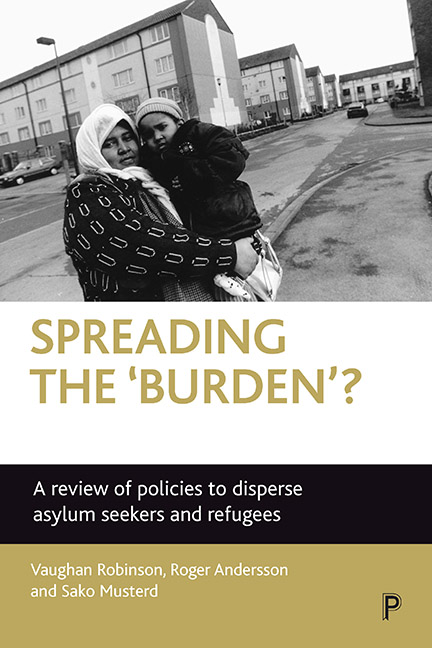Book contents
- Frontmatter
- Contents
- List of tables and figures
- Acknowledgements
- Glossary
- one Introduction
- two Defining the ‘problem’
- three Dispersal policies in the Netherlands
- four Dispersal policies in Sweden
- five Dispersal policies in the UK
- six What works? Improving the efficiency and effectiveness of dispersal
- seven Redefining the ‘problem’ and challenging the assumptions
- References
- Index
- Also available from The Policy Press
two - Defining the ‘problem’
Published online by Cambridge University Press: 20 January 2022
- Frontmatter
- Contents
- List of tables and figures
- Acknowledgements
- Glossary
- one Introduction
- two Defining the ‘problem’
- three Dispersal policies in the Netherlands
- four Dispersal policies in Sweden
- five Dispersal policies in the UK
- six What works? Improving the efficiency and effectiveness of dispersal
- seven Redefining the ‘problem’ and challenging the assumptions
- References
- Index
- Also available from The Policy Press
Summary
Introduction
How did the concentration of asylum seekers and refugees in certain European cities come to be seen as a problem? This chapter provides an account of this development and the national policy action required to solve it. First, it considers the changing position of Europe within the global refugee system and how this has led to a growth in the number of asylum seekers spontaneously entering the continent. Second, it describes how a majority of these asylum seekers have chosen – when they have been allowed to choose – to cluster in certain cities and types of cities having entered Europe. The third section of the chapter discusses some of the pressures that such concentrations have produced. And finally, the chapter shows how these pressures came to be seen as a ‘problem’ by means of the way that they were reported in the media and characterised by politicians. The UK is used as the prime national example throughout this chapter's discussion, and the town of Dover is taken as a local, and nationally emblematic, case study.
Europe's changing place in the global refugee system
The 1990s marked a watershed in Europe's position in the global refugee crisis (Robinson, 1996a). Prior to that decade, several features had characterised the European view of asylum seekers. First, many Europeans considered refugees to be a Third World problem that should be resolved within the Third World; in other words, refugees were of little direct consequence to Europe or Europeans. Refugees created in Africa and Latin America were to be resettled in adjacent countries, and the only European involvement should be the charitable giving of money or aid. Second, where Europe did become involved in Third World refugee episodes, it was largely through admitting finite quotas of carefully selected refugees for settlement under controlled conditions. Third, the European image of refugees was still very much rooted in its experience of the Second World War, in which refugees fled extreme brutality at the hands of oppressive anti-democratic regimes, often during total war. In the public mind, then, ‘refugees’ were white, European and deserving; ‘immigrants’, on the other hand, were black and generally undeserving.
Moreover, such attitudes towards refugees were forged within an atmosphere that was far more benign towards migration in general.
- Type
- Chapter
- Information
- Spreading the 'Burden'?A Review of Policies to Disperse Asylum Seekers and Refugees, pp. 3 - 24Publisher: Bristol University PressPrint publication year: 2003



